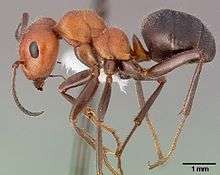Formica obscuripes
Formica obscuripes (the western thatching ant) is a species of ant in the family Formicidae. It is native to North America. It produces large mounds covered by small pieces of plant material.[1] The number of adult workers per colony may be as high as 40,000.[2] F. obscuripes feeds upon a number of insect species, consumes nectar from homopterous insects they tend, and occasionally eats plant tissue.[1] In the Blue Mountains of Oregon, F. obscuripes has demonstrated the capacity for polydomy. A supercolony in a four-hectare study area near Lehman Hot Springs consisted of 210 active nests with an estimated population in excess of 56 million ants.[3]
| Formica obscuripes | |
|---|---|
 | |
| F. obscuripes worker | |
| Scientific classification | |
| Kingdom: | Animalia |
| Phylum: | Arthropoda |
| Class: | Insecta |
| Order: | Hymenoptera |
| Family: | Formicidae |
| Genus: | Formica |
| Species: | F. obscuripes |
| Binomial name | |
| Formica obscuripes Forel, 1886 | |
Nests

F. obscuripes creates distinct, dome-shaped mounds composed of varying materials found in the nest's surrounding environment. This composition is primarily vegetation and is commonly called "thatch". The mounds are typically constructed in areas devoid of cover to expose the nest to sunlight. The size of these mounds is highly variable and is mostly determined by the age and health of the colony. The height ranges from 1 to 18 inches (15-45 cm), although nests of larger heights are not uncommon, and can extend down to 4 ft (1.2 m) in the ground, with chambers present in both the thatched mound and the soil. The condition of the thatched mound is in a constant state of change due to activities by the ants and changes in the environment.[4] To prevent plants from shading the nest, the ants may chew off the bark at the base of plants growing on or nearby the mound. Formic acid is then sprayed into the open layer eventually killing and felling the plants.[5]
References
- Heikkinen, M. W. (1999). "Negative effects of the western thatching ant (Formica obscuripes) on spiders (Araneae) inhabiting big sagebrush (Artemisia tridentata)". Great Basin Naturalist. 59 (4): 380–383.
- Capinera, J. L. (2008). Encyclopedia of Entomology, Volume 3. Springer. p. 4215. ISBN 978-1-4020-6242-1.
- McIver, J.; Torgersen, T.; Cimon, N. (1997). "A supercolony of the thatch ant Formica obscuripes Forel (Hymenoptera:Formicidae) from the Blue Mountains of Oregon". Northwest Science. 71 (1): 18–29.
- Weber, N (1935). "The Biology of the Thatching Ant, Formica rufa obscuripes Forel, in North Dakota. Ecological Monographs," (PDF). Cite journal requires
|journal=(help) - Cole, S.C. Jr. (1932). "The Thatching Ant, Formica obscuripes Forel Psyche Volume 39 (1932), Issue 1-2," (PDF). Cite journal requires
|journal=(help)
External links

- "Formica obscuripes" at the Encyclopedia of Life

- "Discover Life: Formica obscuripes". Retrieved 2010-09-19.
- "BugGuide: Western Thatching Ant - mound - Formica obscuripes". Retrieved 2010-09-19.
- "BugGuide: Western Thatching Ants - Formica obscuripes". Retrieved 2010-09-19.
- "AntWiki: Formica obscuripes". Archived from the original on 2014-07-29. Retrieved 2015-04-19.